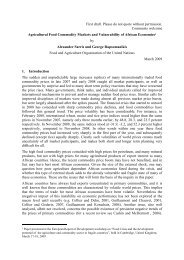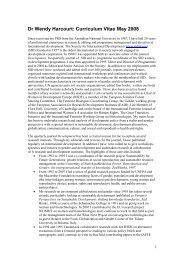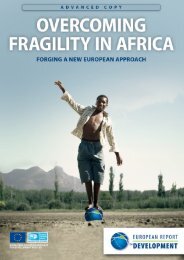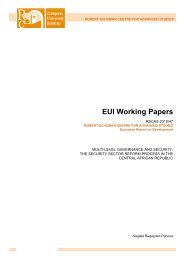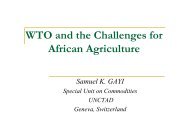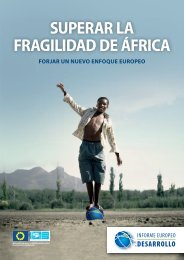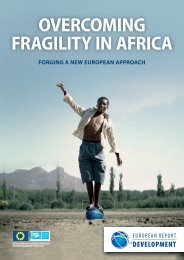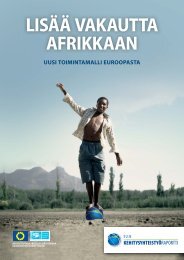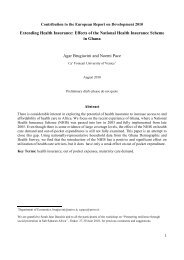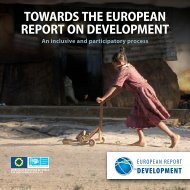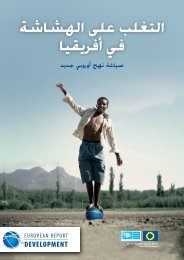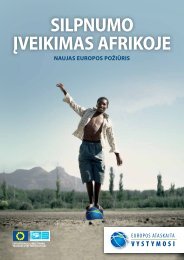LiveLihoods strategies and househoLd resiLience to Food insecurity ...
LiveLihoods strategies and househoLd resiLience to Food insecurity ...
LiveLihoods strategies and househoLd resiLience to Food insecurity ...
You also want an ePaper? Increase the reach of your titles
YUMPU automatically turns print PDFs into web optimized ePapers that Google loves.
LIVELIHOODS STRATEGIES AND HOUSEHOLD RESILIENCE TO FOOD INSECURITY: AN EMPIRICAL ANALYSIS TO<br />
KENYA<br />
crucial role in ensuring the household livelihood, <strong>and</strong> this explains the emphasis that<br />
pas<strong>to</strong>ralists put on the access <strong>to</strong> credit. Conversely, agro-pas<strong>to</strong>ralists <strong>and</strong> smallholders<br />
seem <strong>to</strong> be more concerned about the distance <strong>to</strong> water sources.<br />
These considerations turn immediately in<strong>to</strong> policy implications. In contexts such<br />
as the Northern Kenya districts, livelihood interventions are called for <strong>to</strong> contribute both<br />
<strong>to</strong> saving lives <strong>and</strong> building resilience. The Regional Resilience Enhancement Against<br />
Drought (RREAD) initiative aims precisely at this through lives<strong>to</strong>ck interventions (for<br />
example, de-s<strong>to</strong>cking, supplementary lives<strong>to</strong>ck feedings, emergency veterinary<br />
programmes, transport subsidies <strong>to</strong> support de-s<strong>to</strong>cking, <strong>and</strong> re-s<strong>to</strong>cking of those who<br />
have not ab<strong>and</strong>oned the pas<strong>to</strong>ral system) <strong>and</strong> enhancing water access (for example,<br />
creating <strong>and</strong> re-habilitating wells <strong>and</strong> boreholes, establishing strategic water sources,<br />
subsidised provision of fuel <strong>and</strong> pumps). These results are consistent with the literature<br />
evidence on effective interventions in drought-prone areas of the Horn of Africa (see<br />
Pantuliano <strong>and</strong> Pavanello, 2009).<br />
Another interesting implication can be drawn looking at adaptive capacity. This<br />
component is very important for pas<strong>to</strong>ralists (higher than for anyone else). AC is<br />
composed of years of education, the employment ratio, the food ratio <strong>and</strong> diversity<br />
(which is an indica<strong>to</strong>r for the diversification of household livelihood activities). This, once<br />
again, is strongly robust with the literature evidence on response mechanism <strong>to</strong> drought<br />
(see Section 4.1), which shows that those who are able <strong>to</strong> diversify their activities, for<br />
example, by starting <strong>to</strong> do both herding <strong>and</strong> farming, are among those who cope with<br />
the drought shock better, whilst those whom remained anchored <strong>to</strong> pas<strong>to</strong>ralism were<br />
forced <strong>to</strong> migrate <strong>and</strong> suffered most.<br />
Households in the pas<strong>to</strong>ral regions of Northern Kenya are the ones most exposed<br />
<strong>to</strong> shocks caused by climatic hazard (primarily droughts) <strong>and</strong> pas<strong>to</strong>ralist households are<br />
those who are mainly hit by shocks (as proven by the S component in resilient<br />
analysis). 50 Thus, an overall policy indication is <strong>to</strong> build risk-management mechanisms<br />
<strong>and</strong> insurance schemes for pas<strong>to</strong>ralists in these areas. This is, indeed, what has been<br />
recently proposed by the so-called index-based lives<strong>to</strong>ck insurance (IBLI) scheme (ILRI,<br />
2010). 51 IBLI is a product that is designed <strong>to</strong> protect against drought-related lives<strong>to</strong>ck<br />
mortality. Because index insurance is based upon the realisation of an outcome that<br />
cannot be influenced by insurers or policy-holders (such as the amount <strong>and</strong> distribution<br />
of rainfall over a season), it has a structure relatively simple <strong>and</strong> transparent. This<br />
makes such product easier <strong>to</strong> administer, <strong>and</strong>, consequently, more cost-effective <strong>to</strong><br />
develop <strong>and</strong> trade.<br />
More generally, the resilience analysis supports the findings of extensive research<br />
on drought response carried out in the region over the last decade (see, among others,<br />
Pavanello, 2009) that demonstrates that the disastrous consequences of droughts can be<br />
averted by strengthening <strong>and</strong> protecting pas<strong>to</strong>ral livelihoods systems, building their<br />
resilience <strong>and</strong> capacity <strong>to</strong> survive the inevitable occurrence of drought. Livelihood<br />
interventions, such as lives<strong>to</strong>ck-related initiatives (for example, de-s<strong>to</strong>cking) <strong>and</strong> waterrelated<br />
interventions (including creating <strong>and</strong> re-habilitating wells <strong>and</strong> boreholes),<br />
contribute both <strong>to</strong> saving lives <strong>and</strong> <strong>to</strong> strengthening the resilience of pas<strong>to</strong>ralists. By<br />
equipping communities with the ability <strong>to</strong> manage <strong>and</strong> <strong>to</strong> respond <strong>to</strong> shocks in the early<br />
stages of a crisis, strategic livelihood interventions allow for more timely <strong>and</strong> appropriate<br />
50 It is worth noting that pas<strong>to</strong>ralists are not only hit by animal shocks (which is indeed<br />
straightforward), but they show very high level of crop shock <strong>and</strong> other shocks as well (cf. Table<br />
10).<br />
51 This is an initiative financed by Financial Sec<strong>to</strong>r Deepening (FSD) Kenya / DFID, USAID <strong>and</strong><br />
the World Bank which is being currently piloted in the Marsabit District. The index in IBLI is<br />
predicted lives<strong>to</strong>ck mortality calculated by using a satellite-recorded measure of pasture<br />
availability which is fed in<strong>to</strong> a response function that relates pasture availability with drought<br />
related lives<strong>to</strong>ck mortality. The index threshold above which payouts must be made is 15%<br />
that is IBLI will compensate if predicted lives<strong>to</strong>ck mortality is above 15%.<br />
32



